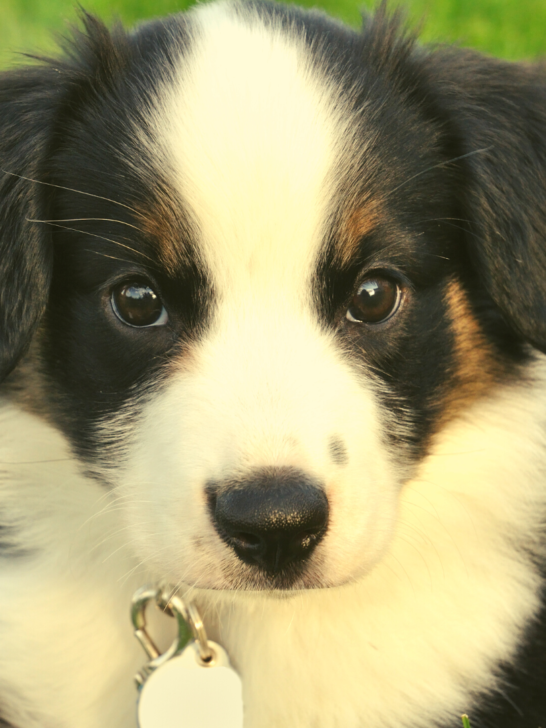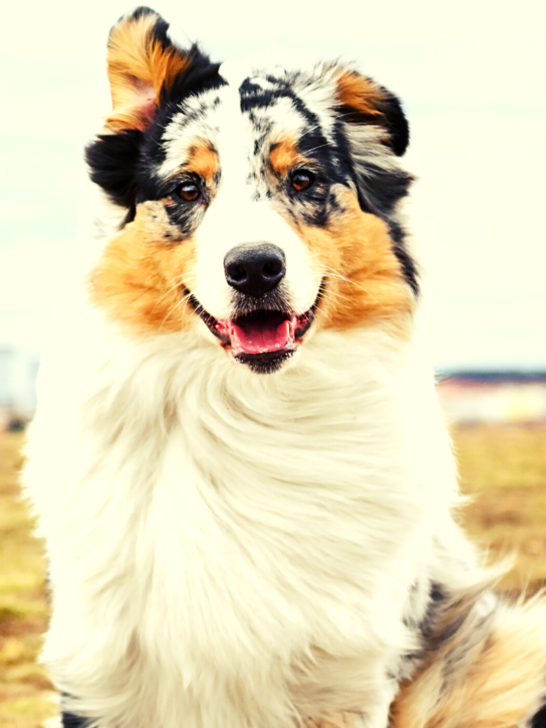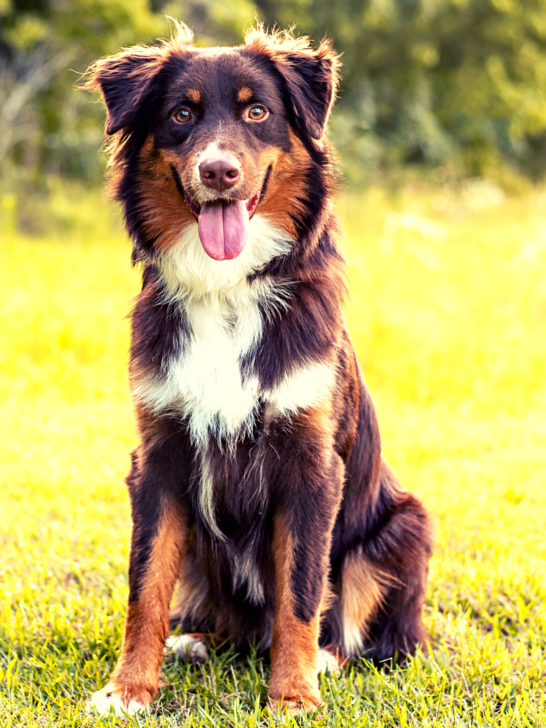The Black Australian Shepherd
If you’re thinking of becoming an owner of a Black Australian Shepherd but don’t know a lot about them, we’re here to help you make a well-informed decision.
In the following article, you will learn all about Black Australian Shepherds, including physical features, temperament and personality, training, care, lifespan, and health conditions.
Getting to Know the Black Australian Shepherd
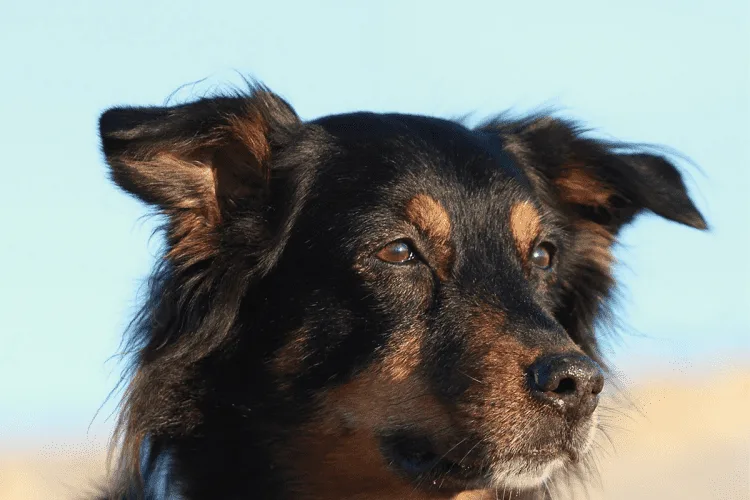
Before we jump into details, let’s talk a little bit about the breed’s origins.
Australian Shepherds came from America in the late 1800s.
Their origin can be traced back to their ancestors, the Pyrenean Shepherds, who came from the mountains of Spain and France.
They arrived in Australia with Basque travelers from the north of Spain who mated their Pyrenean Shepherds with British Collies and produced the Australian Shepherd breed.
The breed quickly became a beloved choice of dog for herding and companionship as it’s loyal, intelligent, and athletic.
Aside from their common Australian Shepherd name, this breed is also called by names like Blue Heelers, Bob-Tails, California Shepherds, Pastor Dogs, New Mexican Shepherds, and Spanish Shepherds.
Physical Features
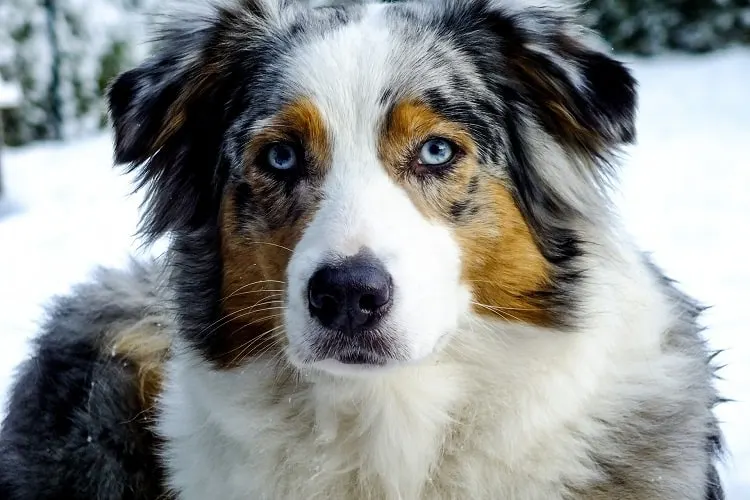
The Black Australian Shepherd is a medium-sized dog with a sturdy build. They weigh around 40 to 60 pounds and are about 18 to 23 inches tall.
Male Australian Shepherds are usually heavier and taller than females.
This breed has a wedge-shaped head with triangular and erect ears. They usually have heterochromia or two different colored eyes, making them absolutely magnificent to look at.
The Black Australian Shepherd also has a double-layered coat: a water-resistant top coat that is medium-length that is either straight or wavy and an undercoat that helps them adapt to hot and cold temperatures.
Its coat is colored black, but some dogs have white markings on the feet and chest area.
The United States Australian Shepherd Association recognizes four primary coat colors:
- Red merle Australian shepherds have red (sometimes known as liver) in their coats, framed by a white or tan base that darkens with age. Aussies with solid red or red merle complexions have crimson lips, noses, and eye rims.
- Blue merle Aussies have black spots on a gray foundation that darken with age.
- Black and blue merle Australian shepherds are known to have black noses, mouths, and eye rims.
Is There a Pure Black Australian Shepherd?
Yes, there is, but it is rare. The solid black color of Australian Shepherds is due to recessive genes.
It’s doubtful to come across an Australian Shepherd with one solid color, but it is possible.
Temperament

Aussies are natural workers.
Because it’s in their nature to spend hours with their owners in the fields herding sheep and cattle, they require routine physical activity, mental stimulation, and obedience training to be healthy and happy.
Hiking, running, and never-ending games of fetch are lovely ways to keep your Aussie happy, healthy, and sufficiently exercised.
Although they are not known to be aggressive, the Aussie’s very devoted nature sometimes causes them to be territorial. They like staying wherever their master or owner is.
Your Aussie will basically follow you anywhere – to the bathroom, your room, or the garden; it’s almost like having a shadow.
A lot of people believe that Australian shepherds are natural guard dogs.
They are constantly vigilant and ready to react whenever they see or feel strangers within the vicinity.
The final verdict is that Black Australian Shepherds are intelligent and eager to please dogs, which makes them excellent companion animals.
Basic Needs
Most Black Australian Shepherds require enough outdoor space where they can run around and be active. It can be as simple as your house’s fenced-in yard.
It’s not advisable to have a Black Australian Shepherd if you’re staying in an apartment unless you’re going to allot your time going out so they can have activities like hiking, walking, or even Frisbee.
Australian Shepherds are perfect for those looking for companionship.
They don’t like being left alone, so if you plan on adopting an Aussie, you must take it everywhere, even to the nearby store.
Australian Shepherds are very active, so you must feed them food rich in carbohydrates, vitamins, minerals, protein, and omega-fatty acids.
Adult Australian Shepherds need at least 2 ½ cups of dog food daily, morning and evening. On the other hand, puppies weighing 8 pounds should be fed ¼ cup of food thrice a day.
Moreover, to support their joints, feed them foods with high levels of glucosamine. You can find it in fish, plant oils, meat meals, and flaxseed.
Exercise

Australian Shepherds need 60 to 90 minutes of exercise per day. You can give them agility courses, ask them to fetch balls, or play frisbee.
These exercises will help repel their excess energy.
Training
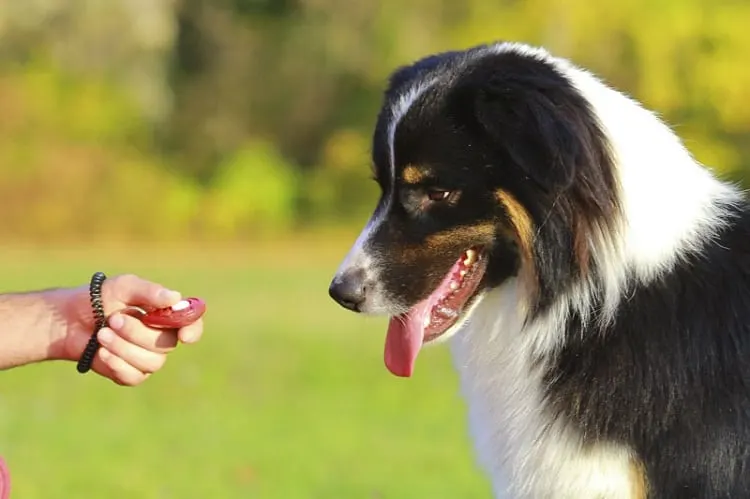
Because Aussies are intelligent dogs, it’s easy to train them. In doing so, remember to reward them for every good behavior they did.
Reinforcement, repetition, and consistency are crucial for its training. Sure, it will require your time, effort, and patience, but it will be worth it.
Below are some tips on how to train your Aussie.
Allow Them to Socialize
Socialize your Aussie as early as possible. Exposing them to strangers and new places is essential so they learn about the world around them.
All you have to do is walk them around the neighborhood, go to dog parks, or do some errands where they can participate and socialize.
We can guarantee that your Aussie will absolutely love the attention it will get from strangers and other friendly neighborhood dogs.
Reward System
Positive reinforcement training results in good behavior. This type of training encourages your dog to act on the preferred behavior and get a reward every time.
A famous example is teaching your dog how to sit.
With time and patience, it will become a win-win for both you and your dog – you will be proud, and it will get a yummy treat.
Short but Frequent Training Sessions
Short training sessions have proven more beneficial for dogs as they help them focus better.
Longer training sessions that go over 30 minutes will tire them and make them lose interest.
Once the training session is done, play with your Aussie to get it excited for the next training drill.
Use Consistent Commands
Clear communication is a critical element of training your Australian Shepherd.
If you’re going to teach something, pick a specific word and stick to it until your dog gets it.
Do not use different commands because that is confusing for them.
Also, you should say it correctly because dogs can tell by your voice if you’re angry or frustrated.
Caring for a Black Australian Shepherd
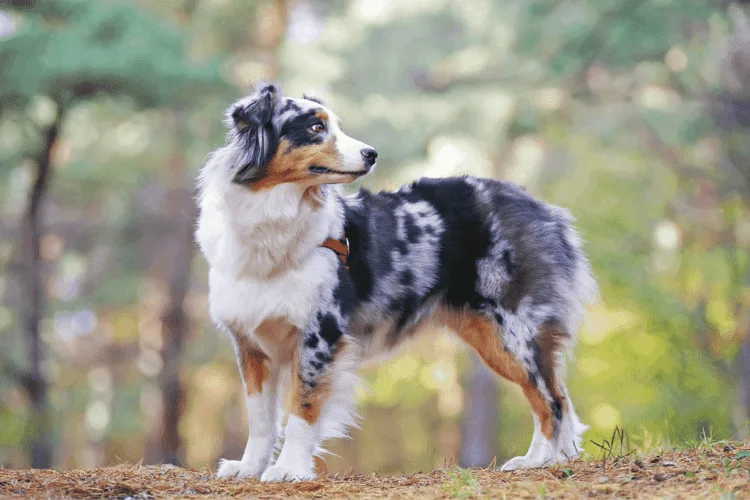
Black Australian Shepherds are low-maintenance dogs, but there are still a few things to consider.
Grooming
As mentioned before, Black Aussie Shepherds have a double-layered coat.
The top coat is water-resistant and does “self-cleaning,” which means that your dog requires fewer baths compared to other breeds.
However, you need to brush its coat at least twice a week with a slicker brush to help control matting and shedding, and to clear out any debris on the skin.
Brushing your dog’s coat, especially during shedding periods, can help ensure their clean and healthy coat.
In addition, brushing can also be a way to check their nail length and coat sheen.
You don’t need to shave your Aussie’s coat because it might not grow back, which can lessen the dog’s ability to regulate its temperature.
Full Body Check
You should also regularly inspect your Aussie’s teeth and ears to prevent bacteria buildup and reduce the risk of periodontal diseases and infections.
Also, always check their eyes to see if there is dryness, irritation, or excess tears. You must act fast if you spot any early signs of eye infections.
Aside from their physical features, you must also monitor their mental health.
They need constant mental stimulation to fight boredom because they get frustrated when they are bored.
Boredom also results in them being destructive.
Shedding
The Black Australian Shepherd sheds during summer to keep themselves cool on hot and sunny days.
Their coats will regain their thickness in fall and early winter to help them stay warm and dry.
If you are allergic to dander, you should buy hypoallergenic dogs that shed just a little.
Surely, the Australian Shepherd does not fall under this category of dogs.
Lifespan

Similar to other popular breeds like Labrador Retrievers and Golden Retrievers, Australian Shepherds have a life expectancy of between 10 and 15 years.
Of course, the life expectancy of any dog, regardless of the breed, depends on factors like diet, exercise, genetics, and stress.
Naturally, dogs that are well-cared for and live in a healthy environment are likely to live longer than those that do not.
Common Health Problems

Australian Shepherds are among the strongest and healthiest breeds of dogs, but that doesn’t mean they don’t have any health issues.
Below are some of the most common ones.
Elbow and Hip Dysplasia
Hip dysplasia appears when a hip joint does not properly fit into the hip socket, resulting in debilitating and progressive joint ailments.
The partial separation of the joint and socket causes mobility restriction.
Australian Shepherds do not exhibit early indications of hip problems until they become severe.
If left unchecked, hip dysplasia might develop into other joint issues such as lameness and arthritis.
It’s critical to detect early symptoms so treatment can start immediately.
Australian Shepherds are also prone to elbow dysplasia.
Elbow dysplasia affects the front limbs and is most evident when performing activities requiring elbow joints to bend, such as sitting and standing.
Like hip dysplasia, elbow dysplasia affects and restricts a dog’s mobility.
Both conditions can be devastating to your Aussie because they are an active and highly-energetic breed. Being unable to run around and exercise will affect their mental health severely.
Autoimmune Diseases
Allergies and hyperthyroidism are the two most prevalent autoimmune diseases in Australian Shepherds.
Hyperthyroidism is a thyroid gland inflammation that can occur on one or both sides.
Although your dog’s thyroid performs many vital functions, it’s also responsible for regulating body temperature and energy levels.
Excess thyroxine in circulation signals your dog’s body to start burning more calories.
Because of this, the metabolism begins to break down, which is detrimental to the digestive system, liver, and kidneys.
Allergies are also common to Australian Shepherds. Grasses, wheat, food, and pollen are this breed’s three most common allergens.
Allergies generally develop over time, which is why a middle-aged dog is more likely to experience an allergic reaction than a younger dog.
Eye Problems
Cataracts is when the eye’s natural lens becomes cloudy.
Unfortunately, that’s a common problem for Australian Shepherd dogs because their eyes are susceptible to light.
If left untreated, it often progresses to permanent blindness.
Coloboma is an eye issue that affects light perception and management.
If it happens, the cornea prevents light from being filtered as it enters the eye, resulting in constant squinting or eye closing.
This disease is incurable, but you may give your dog a doggie eye patch to make him more comfortable.
Epilepsy
Idiopathic Epilepsy is a typical form of canine epilepsy characterized by one or more epileptic episodes that lack a known cause.
It’s critical to remain calm and let your dog go through epileptic attacks such as seizures.
Clear the route of your snarling Aussie so that they don’t hurt themselves and wait for the episode to pass. Seizures are frightening but curable.
Note that seizures reflect more severe health or structural problems with your dog’s brain, so it’s essential to get him examined.
To prevent and treat future seizures, your Vet will collaborate with you and your dog to establish a treatment plan.
How Much do Black Australian Shepherds Cost?

Depending on the color, availability, and breeder, an Australian Shepherd puppy can range from $800-$1,800.
If you decide to buy an Australian Shepherd, don’t forget about the many other expenses associated with fulfilling its basic needs, plus grooming, training, vitamins, proper food, and possible vet fee.
Conclusion
Now that you’ve accumulated enough information about Black Australian Shepherds, do you still think it’s the right breed for you?
If so, research reputable breeders and get as much information as possible before making your final decision.
Remember, Aussies are loyal and can become a great addition to your family, but they do require tons of exercise and proper socialization to live a long and happy life. Are you ready for the challenge?
Resources:


























